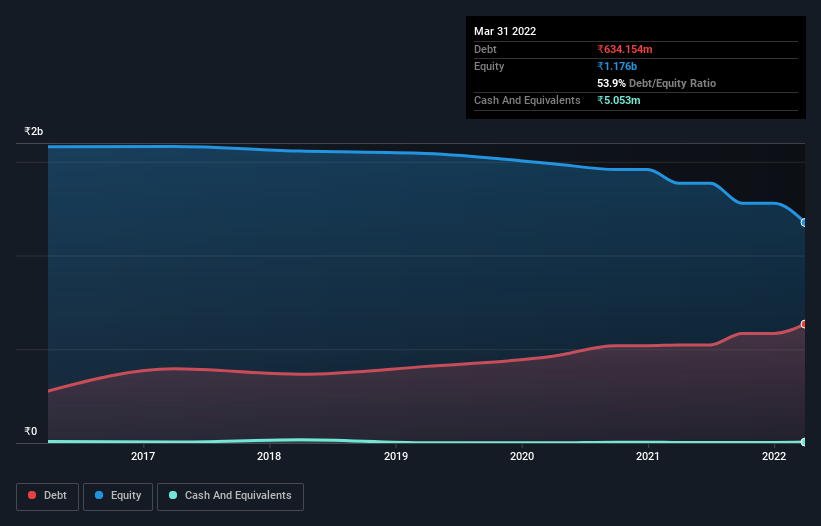
Some say volatility, rather than debt, is the best way to think about risk as an investor, but Warren Buffett famously said that 'Volatility is far from synonymous with risk.' It's only natural to consider a company's balance sheet when you examine how risky it is, since debt is often involved when a business collapses. We can see that Cinevista Limited (NSE:CINEVISTA) does use debt in its business. But should shareholders be worried about its use of debt?
When Is Debt A Problem?
Debt assists a business until the business has trouble paying it off, either with new capital or with free cash flow. If things get really bad, the lenders can take control of the business. However, a more frequent (but still costly) occurrence is where a company must issue shares at bargain-basement prices, permanently diluting shareholders, just to shore up its balance sheet. Of course, plenty of companies use debt to fund growth, without any negative consequences. When we examine debt levels, we first consider both cash and debt levels, together.
View our latest analysis for Cinevista
What Is Cinevista's Net Debt?
As you can see below, at the end of March 2022, Cinevista had ₹634.2m of debt, up from ₹523.0m a year ago. Click the image for more detail. Net debt is about the same, since the it doesn't have much cash.

How Strong Is Cinevista's Balance Sheet?
According to the last reported balance sheet, Cinevista had liabilities of ₹46.3m due within 12 months, and liabilities of ₹633.7m due beyond 12 months. On the other hand, it had cash of ₹5.05m and ₹75.9m worth of receivables due within a year. So its liabilities total ₹599.0m more than the combination of its cash and short-term receivables.
This is a mountain of leverage relative to its market capitalization of ₹920.7m. This suggests shareholders would be heavily diluted if the company needed to shore up its balance sheet in a hurry. There's no doubt that we learn most about debt from the balance sheet. But it is Cinevista's earnings that will influence how the balance sheet holds up in the future. So if you're keen to discover more about its earnings, it might be worth checking out this graph of its long term earnings trend.
In the last year Cinevista wasn't profitable at an EBIT level, but managed to grow its revenue by 22%, to ₹10m. Shareholders probably have their fingers crossed that it can grow its way to profits.
Caveat Emptor
Over the last twelve months Cinevista produced an earnings before interest and tax (EBIT) loss. To be specific the EBIT loss came in at ₹25m. When we look at that and recall the liabilities on its balance sheet, relative to cash, it seems unwise to us for the company to have any debt. Quite frankly we think the balance sheet is far from match-fit, although it could be improved with time. Another cause for caution is that is bled ₹67m in negative free cash flow over the last twelve months. So in short it's a really risky stock. When analysing debt levels, the balance sheet is the obvious place to start. However, not all investment risk resides within the balance sheet - far from it. Be aware that Cinevista is showing 4 warning signs in our investment analysis , and 3 of those are a bit concerning...
At the end of the day, it's often better to focus on companies that are free from net debt. You can access our special list of such companies (all with a track record of profit growth). It's free.
If you're looking to trade Cinevista, open an account with the lowest-cost platform trusted by professionals, Interactive Brokers.
With clients in over 200 countries and territories, and access to 160 markets, IBKR lets you trade stocks, options, futures, forex, bonds and funds from a single integrated account.
Enjoy no hidden fees, no account minimums, and FX conversion rates as low as 0.03%, far better than what most brokers offer.
Sponsored ContentNew: AI Stock Screener & Alerts
Our new AI Stock Screener scans the market every day to uncover opportunities.
• Dividend Powerhouses (3%+ Yield)
• Undervalued Small Caps with Insider Buying
• High growth Tech and AI Companies
Or build your own from over 50 metrics.
Have feedback on this article? Concerned about the content? Get in touch with us directly. Alternatively, email editorial-team (at) simplywallst.com.
This article by Simply Wall St is general in nature. We provide commentary based on historical data and analyst forecasts only using an unbiased methodology and our articles are not intended to be financial advice. It does not constitute a recommendation to buy or sell any stock, and does not take account of your objectives, or your financial situation. We aim to bring you long-term focused analysis driven by fundamental data. Note that our analysis may not factor in the latest price-sensitive company announcements or qualitative material. Simply Wall St has no position in any stocks mentioned.
About NSEI:CINEVISTA
Cinevista
Produces television serials, ad commercials, and feature films in India and internationally.
Low and slightly overvalued.
Market Insights
Community Narratives




